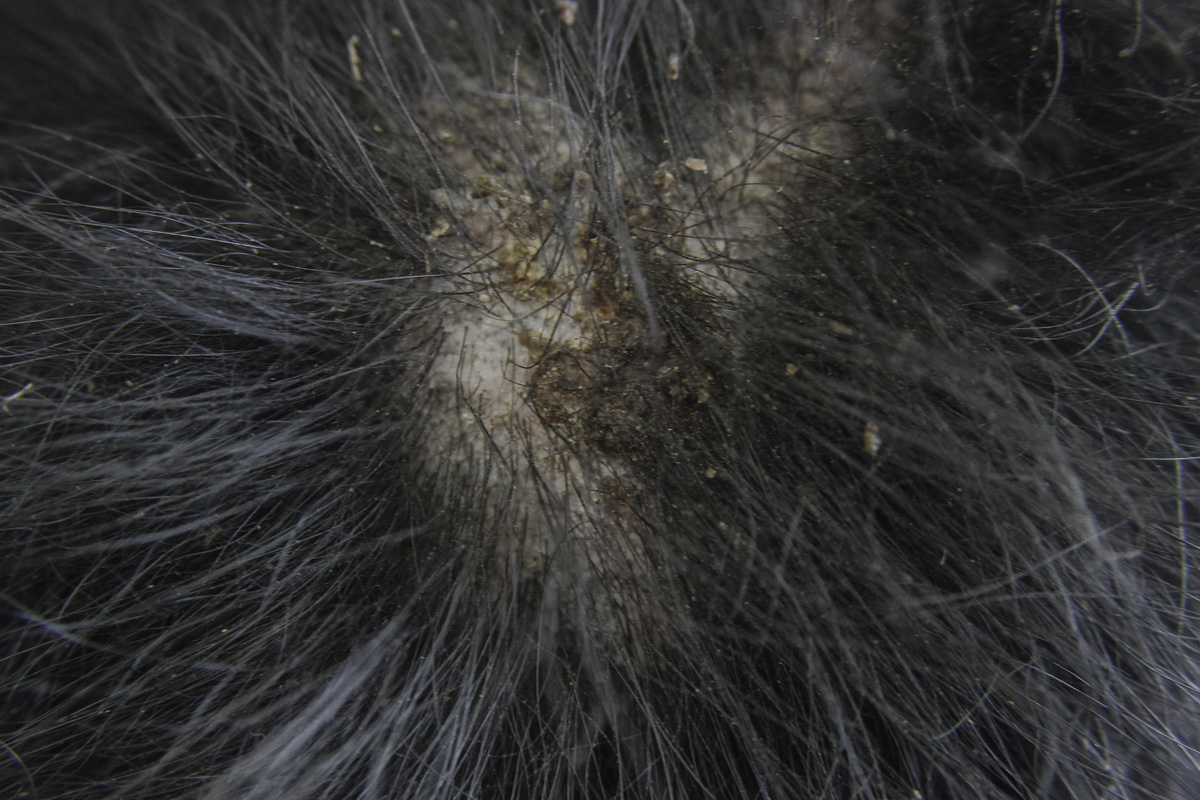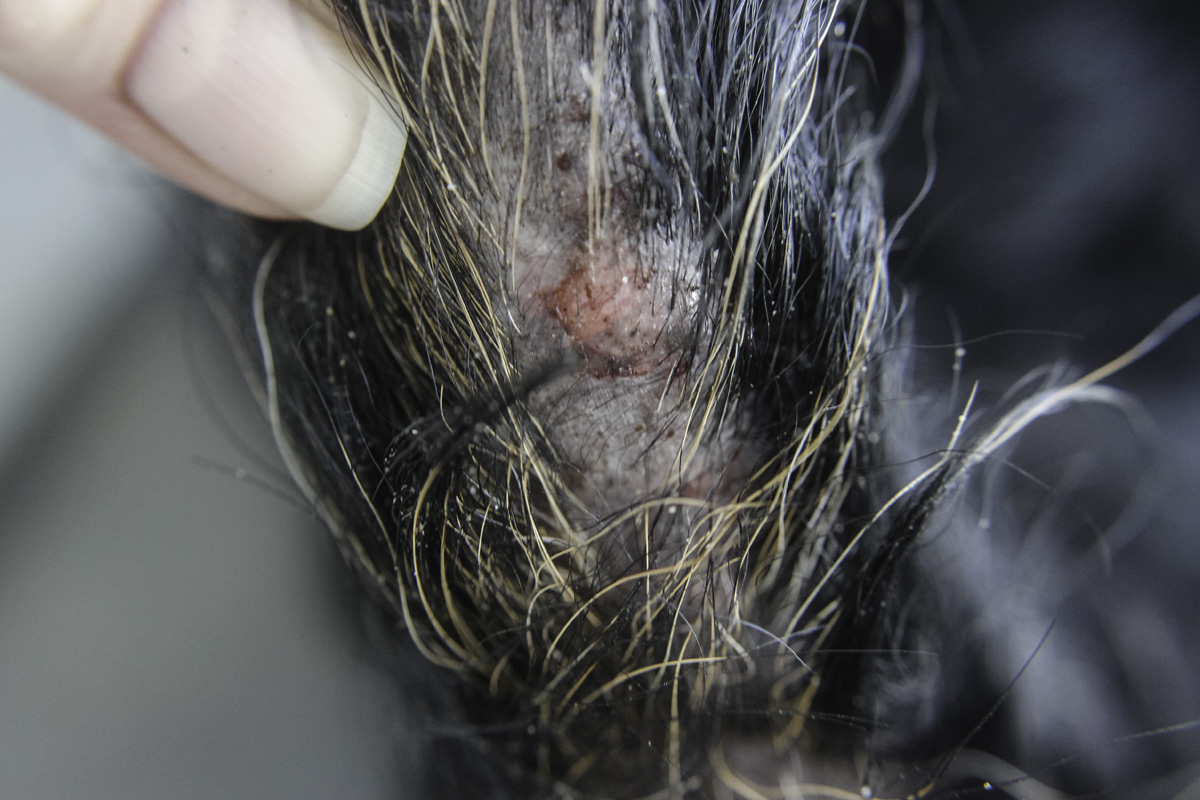I know how upsetting it is to have a dog who is suffering from flea allergy dermatitis. One flea can turn my dog’s (and my) world upside-down. Within 24 hours he can develop a full-blown flair up.
I’m going to show you how to treat flea allergy dermatitis in dogs naturally. You can cure your dog’s flea allergy dermatitis without the use of chemicals and once you know what to use, you’ll be able to stop any future flareups in their tracks.
There are 5 natural treatments I swear by for how to heal flea allergy dermatitis in dogs naturally. I’ll give you a breakdown of each and explain how to apply each.
What is Flea Allergy Dermatitis on Dogs?
Let’s cover how to treat flea allergy dermatitis in dogs naturally by first talking about what flea allergy dermatitis is.
Flea allergy dermatitis is also known as flea bite hypersensitivity. It is the most common dermatologic disease of domestic dogs in the US.
Flea allergy dermatitis is most common in the summer months, although in warm climates such as Florida (where I live) flea issues and a tendency towards allergies in general may persist throughout the year.
What Causes Flea Allergy Dermatitis in Dogs?
Fleas inject saliva that contains a variety of histamine-like compounds, enzymes, polypeptides, and amino acids. They do so while feeding.
Dogs can develop either immediate (15 min) or delayed (24–48 hr) reactions, or both.
Dogs who are exposed continuously to flea bites have low levels of circulating antibodies in their bodies from the fleas’ saliva. They either do not develop skin reactions or develop them later and to a considerably reduced degree.
In hypersensitive dogs flea allergy dermatitis can be intense and may show up all over the body.
- lower back (most common place)
- tailhead
- entire tail
- thighs
- inner thighs
The rump and tailhead areas are typically the first, most evident, areas affected.
Signs of Distress
- scratching
- licking
- rubbing
- chewing
- nibbling
If you have a light-colored dog the hair may be stained brown from the licking.
Common Secondary Lesions
- alopecia
- erythema
- hyperpigmented skin
- scaling
- papules
- broken papules covered with reddish brown crusts
From scratching, your dog can also develop hotspots. Typically, behind the ears, on the neck and shoulders. I have a quick, simple, inexpensive and effective remedy for hotspots.
It’s important to note that extremely hypersensitive animals might be virtually free of fleas but still show these symptoms and signs. Also, a secondary bacterial skin infection can be associated with flea allergy dermatitis.
How to Treat Flea Allergy Dermatitis in Dogs Naturally
Below are 5 ways that I have personally treated, cured and prevented flea allergy dermatitis in my hyper-sensitive dog. Because these are gentle, natural remedies you can play around with each and find what works best for you and your dog. Just be sure not to overdo it and try everything at once. Try one thing at a time and give it some time to work before moving on to the next.
- Apple Cider Vinegar
If you know me you know that I use apple cider vinegar for everything! I add it to all of my animals’ water or meals and have cured many ailments with this magical liquid.
See how I healed my dog’s histiocytoma with apple cider vinegar!
First, I highly recommend that you add a dash of apple cider vinegar to your dog’s meals. A little bit goes a long way to boost your dog’s immune system (something he/she desperately needs if they’re suffering from flea allergy dermatitis) and improve their overall health.
For application, fill a spray bottle with 1/3 apple cider vinegar and 2/3 water. Spray this solution on your dog’s hair and skin 2-3 times per day.
You want to spray the infected areas thoroughly, making sure the solution reaches the skin. You also want to spray the skin around the infected areas to prevent spreading of the flea allergy dermatitis.
This remedy works steadily. A week or two is needed before you’ll see a vast improvement.
- Castor Oil
Castor oil isn’t a preventative but is the fastest cure I’ve found for how to treate flea allergy dermatitis in dogs naturally.
Not only does it heal the skin, it also promotes rapid hair regrowth. Additionally, my dog hates the taste so it stops him from chewing on himself.
All around, castor oil is a great natural treatment for quick results!
Castor oil contains Vitamin E, proteins and omega-6 and omega-9 fatty acids that are key components responsible for good hair and skin.
Massaging castor oil into your dog’s skin will help improve blood flow to the area and promote faster healing.
Because my dogs spend most of their day outside and they have a sunroom all their own to sleep in at night, allowing them to sleep inside without roaming through the entire house, I’m able to use oils on them. If you have an inside dog and you do decide to try castor oil, you’ll want to crate them while the oil absorbs into their skin, so as not to get oil all over the house.
- Aloe Vera
Aloe Vera gel has done wonders for my own hair and scalp. It is also widely used to treat skin diseases in dogs. The anti-bacterial and anti-fungal properties of Aloe Vera stimulate the healing process and also provide better skin protection from recurring flare-ups.
Aloe Vera gel can be applied directly to the itching skin surface. It also absorbs quickly and I haven’t ever had it stain anything it’s come in contact with. For instance, my pillow stays clean when I use Aloe Vera in my hair before bed.
- Thyme
Thyme (that’s right, the herb) is a natural remedy for pain, redness and swelling, and perfect for how to treat flea allergy dermatitis naturally. Make an infusion with it, let it cool, then clean your dog’s flea allergy dermatitis with it.
Soak a cotton ball with the thyme solution and apply to the affected areas. Repeat the process daily until you start to see improvement.
Always apply warm compresses, never hot.
- Turmeric Golden Paste
Not only can you feed turmeric golden paste to your dogs (and eat it yourself!) to reduce inflammation and improve health, turmeric golden paste can be used topically. Yes, even the black pepper in turmeric golden paste can be beneficial when used topically.
Generously apply the paste to your dog’s infected area. If you need to apply it to a place that your dog will lick it off or it will rub off pretty quickly, wrap the area with Vet Wrap or have your dog wear a cone while the turmeric does its job.
Warning: Don’t put turmeric on open wounds. It is a blood thinner and will cause bleeding. Also, turmeric gets everywhere and stains nearly ever surface it touches. If you do apply turmeric you want to keep your dog outside.
Preventing Flea Allergy Dermatitis
The most obvious way to prevent flea allergy dermatitis is to keep your dog flea-free. No matter how good of a pet parent you are, you can’t work miracles! Fleas will find your dog again, eventually.
There’s also the possibility that the flea allergy dermatitis is simply an allergy, not necessarily one to fleas. So, no matter how flea free your dog is, they may not be the cause.
Your goal, starting today, needs to be improving your dog’s immunity through their diet.
Here are some examples of what I mean:
- Add a dash of apple cider vinegar to each meal.
- Feed bone broth regularly.
- Add turmeric golden paste to their meals each week.
- Eliminate processed foods. Take the plunge and start your dog on a raw diet!


Hi my 8yrs rescue Chihuahua is raw Fed but gets awful flea allergy dermatitis if he gets fleas ,we have been on natural treatment and flea free for 3 years but we have just taken in a feral kitten(treated the day we got him) which has caused it again sadly and he’s got sore and dirt stained armpits and inner thighs I have relented and used a chemical spot on and home treatment this once to hopefully rid him of them but he’s still reacting what is the best thing to help him overcome this please
Hey Kat. To be perfectly honest, sometimes the best option in a case like this is oral treatment from your vet. I hate to say that because it’s nasty stuff and isn’t the least be healthy. I had one dog who was causing flea outbreaks and I eventually relented (just like you) and gave him an oral treatment. It fixed everything. I didn’t have to treat any other dog. Just him. Then everyone was magically flea-free after that. At the same time, I had someone spray my yard with Dawn Dish Soap and water. It probably helped too. I just don’t know how much because I did the two things within days of each other. I hope this helps!